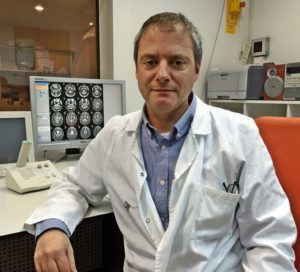Jordi Riba was an ethnopharmacologist and trailblazer in psychedelic and consciousness research, particularly in the study of ayahuasca. Dr. Riba was born in 1968 in Spain and passed away in August 2020 at the age of 51.
Dr. Riba received a B.S. in Pharmacy at the University of Barcelona (1993), a Masters in Biomedical Engineering at the Universitat Politècnica de Catalunya (2002), and a PhD in Pharmacology at the Autonomous University of Barcelona (2003). His Doctoral Thesis, Human Pharmacology of Ayahuasca, focused on the world’s first placebo-controlled clinical trial of ayahuasca’s neurological impacts, using a standardized preparation of freeze-dried ayahuasca.1
Dr. Riba completed his postdoctoral neuropsychology research at Magdeburg University in Germany (2004-2006) and worked as an associate researcher at the Drug Research Center at Barcelona’s Sant Pau Hospital (2007-2018). For eight of those years, he taught pharmacology at the hospital. In 2013, the hospital formed a partnership with Beckley Foundation, the Beckley/Sant Pau Research Programme, to deepen scientific understanding of ayahuasca’s active principles. Dr. Riba worked as a researcher at Maastricht University in the Netherlands from 2018 until his passing.
Dr. Riba’s early research focused on alkaloids and their neurological impacts. He translated the Pharmacotheon written by Jonathan Ott into Spanish2 at the recommendation of Anthropologist Josep Maria Fericgla. Through the process, he became drawn to the cultural and ritualistic use of ayahuasca. In a 2016 interview with Oliver Taymans, Dr. Riba stated,
For me it was important that it had a cultural use, that it was not merely a recreational substance. I thought the fact that there might be a religion around the use of a psychoactive plant, that cultures had evolved around the use of these plants for many centuries, gave an added interest.
To study the neurological effects of acute and long-term use of ayahuasca, Dr. Riba has used brain imaging techniques such as SPECT (Single Photon Emission Computed Tomography, measuring blood flow) and EEG (electroencephalography). His work helped to reveal ayahuasca’s neurogenic potential — in other words, its ability to support the growth of new brain cells.3,4 This finding indicated promise for the treatment of neurodegenerative disorders such as Alzheimer’s and Parkinson’s.5 Other studies illuminated parallels between the short-term effects of ayahuasca and those of extensive mindfulness practice.6 His later investigations underscored ayahuasca’s potential to treat major depression.7 Dr. Riba also told Taymans in their 2016 interview,
Ayahuasca reduces the expectations you have, and you are re-experiencing stored memories, for instance, in a very different way. So it helps you to take some distance or have a new outlook on things that…you’ve already experienced. I think this is quite valuable, and this is what might give ayahuasca its therapeutic potential.”
Other substances Dr. Riba investigated include Salvinorin-A,8 cannabis,9 and 5-MeO-DMT.10
Dr. Riba has presented on ayahuasca at Psychedelic Science 2013 and 2017, at the Interdisciplinary Conference on Psychedelic Research 2016, and on Salvinorin-A at Psychedelic Science 2017. He has been published in international journals including, European Neuropsychopharmacology, Psychopharmacology, The British Journal of Clinical Pharmacology, Journal of Psychoactive Drugs, Neuropsychobiology, and others. In 2017, Rolling Stone honored Dr. Riba, naming him among the top 25 most influential people in the future of science.
More about Jordi Riba’s work can be found on his ResearchGate profile.
